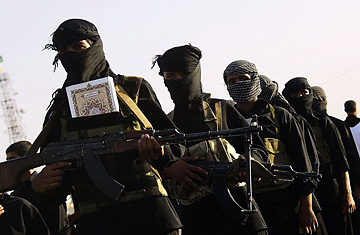
Iraqi militiamen of al-Mahdi army carry their guns in a parade to mark the 2nd anniversary of fighting in Najaf between the militia and U.S military, August 5, 2006.
Across Baghdad, U.S. forces are fighting a kind of shadow war against the Mahdi Army, which American troops call "JAM" — shorthand for the group's Arabic name Jaish al-Mahdi. The two sides rarely take shots directly at each other. When the Mahdi Army strikes, usually Sunnis under the protection of U.S. forces become casualties. Mosques explode. Houses burn. Mutilated bodies appear on streets that American troops claim to control. U.S. forces answer with raids on suspected Mahdi Army houses in neighborhoods like Shula, just north of Ghazaliya. Sometimes they uncover arms caches and make arrests. More often the doors they kick in lead to empty rooms where Mahdi Army fighters have left only tiny traces of themselves, such as undelivered threat letters and spent bullet casings.
The struggle has gone on like this for months, ever since the Mahdi Army began pushing westward across Baghdad in the spring with organized campaigns aimed at transforming Sunni neighborhoods into Shi'ite strongholds. But U.S. patience may be coming to an end in the wake of the execution of Saddam Hussein, whose passing left Sadr as the one visible face of opposition to American efforts in Iraq. A Pentagon report released in December described the Mahdi Army as the main threat to stability in Iraq. And the U.S. military upped the stakes with Sadr during a recent raid against the Mahdi Army in Najaf, where U.S. forces killed a senior Sadr aide, Sahib al-Amiri, in the same Shi'ite holy city where the cleric lives. But Sadr's forces continue to show their strength throughout Baghdad even so, driving the daily rhythm of sectarian violence in the city with orchestrated attacks against Sunnis. Sadr even managed to cast an ominous voice into Hussein's death chamber, where Sadr loyalists among the government witnesses of the hanging chanted "Moqtada, Moqtada, Moqtada" as a taunt to the former dictator moments before he died. The scene added yet another notch in the tension building between U.S. forces and the Mahdi Army, leaving many wondering how long the two sides will eye each other before flying into open conflict.
In Ghazaliya, battle lines are already forming. The Mahdi Army began a southward push through the neighborhood in the summer, clearing Sunnis from the area house by house (see story). U.S. forces hope to halt the Mahdi Army's advance, which shows no signs of slowing. American soldiers are throwing up roadblocks around the front-line area in an effort to stop southward incursions by Shi'ite death squads using cars. Platoons patrol the area in Humvees and on foot as well trying to deter both sides from fighting. But the patrols can only cover so much ground, and gunfights often erupt along the streets, marking Ghazaliya's no-man's land.
Peterson says the fighting usually starts with an attack by the Mahdi Army. A bookish officer who grew up in northwest Indiana, Peterson has made a study of the Mahdi Army over the past several years. Shortly after the U.S. invasion, Peterson was a commander in a tank company that oversaw Sadr City, the Shi'ite slum on the east side of Baghdad the Mahdi Army calls home. Later Peterson spent time in Najaf, where U.S. forces and the Mahdi Army clashed openly in 2004 in battles many on both sides see as unfinished. Peterson says the Mahdi Army, as an organization, has grown more sophisticated politically and tactically over the years, morphing from a band of thugs led by a reckless young cleric into something much scarier.
"I perceive the JAM to be like the Nazi Party," says Peterson, drawing parallels between Germany in the years before World War II and Iraq today. Peterson sees the political figures loyal to Sadr deftly taking advantage of weaknesses in a nascent parliamentary system. Meanwhile, henchmen exert power on the streets through terror that comes with a brand name and a famous face. "You did have the Gestapo in there," Peterson says of the Nazis. "And if I look at the JAM, that's what they got going on right now."
What, exactly, U.S. forces can do now to thwart the ongoing rise of Sadr's forces remains uncertain as the White House mulls its next move in Iraq. More than a few U.S. soldiers would welcome a chance to take the fight against the Mahdi Army into Sadr City, where Shi'ite death squads find safe harbor. Many troops feel the only way to deal with Sadr's army is to take it apart. But the Mahdi Army is only one part army anymore. The political wing of Sadr's ranks includes 30 parliamentarians and four ministry heads from the government of Iraqi Prime Minister Nouri al-Maliki, whose shaky hold on authority loosened further still after the Sadr bloc launched a boycott in November that continues. That means any decision to confront Sadr is as much political as it is tactical. "We're in the capital," says Lt. Col. James Nickolas, the commander of U.S. forces in Ghazaliya, who plans simply to hold the line against the Mahdi Army until the White House offers a new strategy. "Politics weighs a little bit more heavily."
